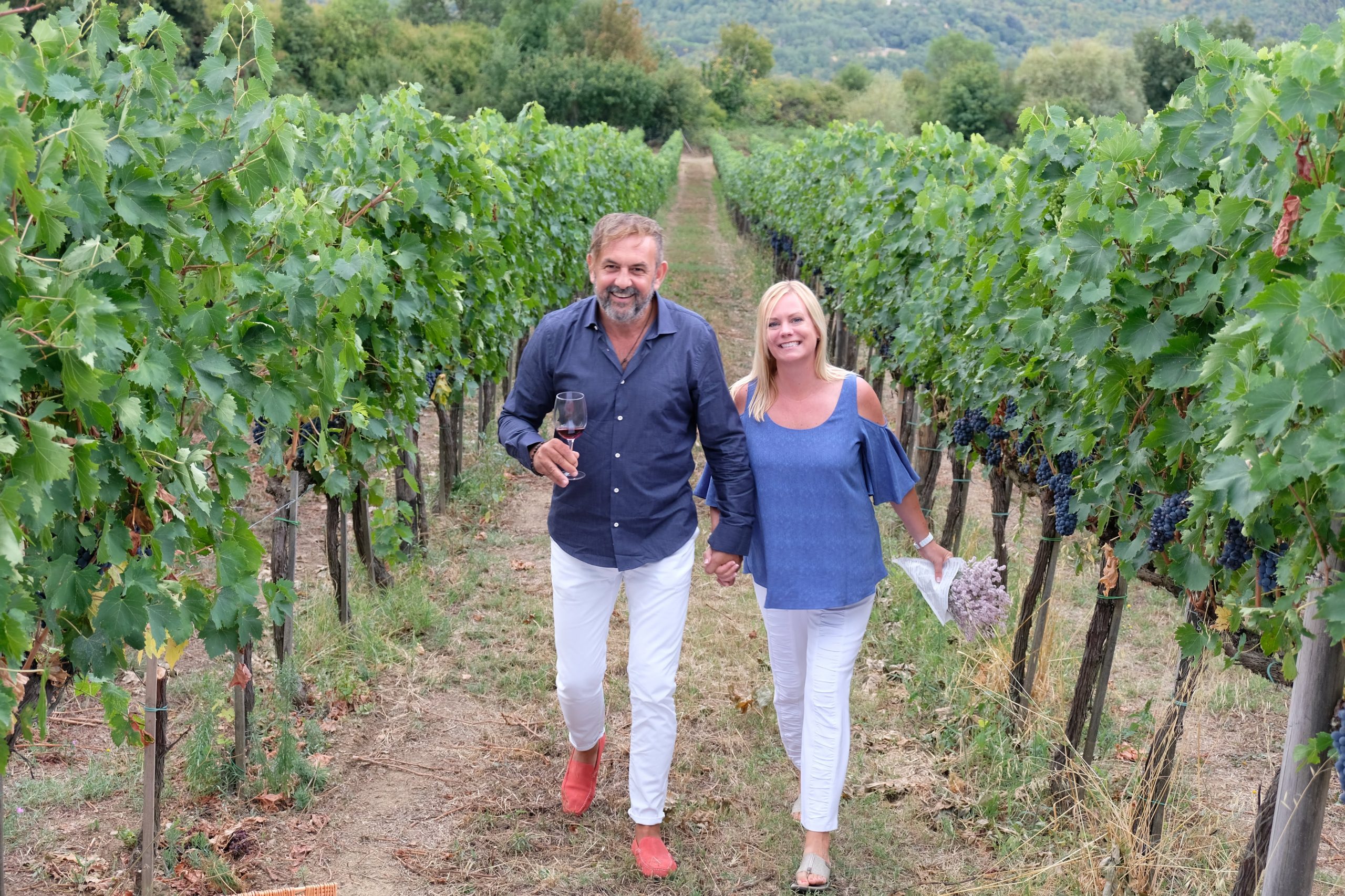Natural Sustainable Charcuterie Products
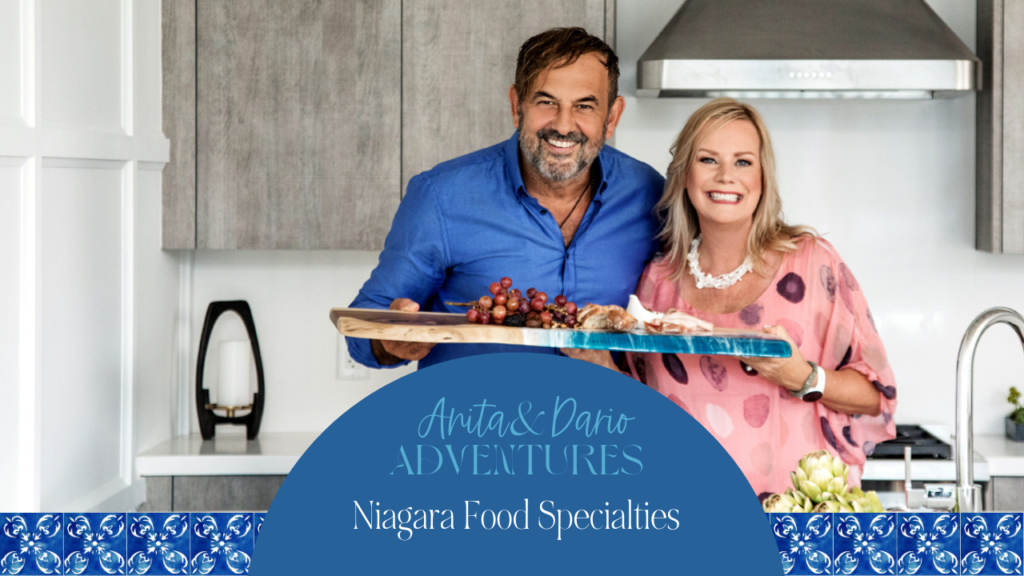
This is an interview that we did with Niagara Food Specialties where we discussed choosing the best meat for a charcuterie board and cooking. Niagara Food Specialties are based in Ontario, Canada and are now expanding into the USA. They specialize in quality, sustainable meat products and share with us exactly why sustainability is important as well as why the process is important to taste and health? Quality is king at Niagara Food Specialties.
Anita & Dario Adventures Inspired Living Interview
Introducing Niagara Food Specialties
Dario: We do not miss any little tips that Mario is going to give us.
Anita: So we have Mario from Niagara Specialties, he’s the co-owner of this Canadian-born company. Dario has used him for years. So we’re going to get the two of them talking. We’ve got some great pictures and slides of the products, because this is top notch for charcuterie boards, for cooking with, for eating, you’re going to love it. So we’re going to share some of those.
This is Anita and Dario’s Adventures, and we’re listening to you. You asked for more product information, more interview information. So that’s what we’re doing and bringing on more quality things around food and travel.
Anita: A couple of things I wanted to cover. First, Niagara Specialties is a top-notch product and we are offering a special offer for our International Dinner Club members we will be explaining more later in this hour segment.
We also have some free resources that are available at OliveYourLife.org. We’ve got Three Secrets: From Bored to Inspired, we’ve got the Eight Principles of the Mediterranean Lifestyle sheet that you can download. We are the olive branch to the Mediterranean lifestyle and way of living.
Anita: And we also have our challenge that’s coming up on November 15th. So if you see this before November 15th, you’re going to love it if you join. The challenge for food and travel lovers. It’s about getting inspired again. If you’re bored with what you’re cooking if you’re wanting to find more adventure in your life. Health & Happiness Hacks Free 5 Day Challenge
Dario: This is the best thing about a live interview. You improvise things, things start just happening.
Anita: How do you guys know each other? Where did you meet? Let’s hear a little bit of history because that’s always exciting.
Mario: One man who had a vision, his name is Ferruccio Della Valle.
Dario: No, that’s right. Yeah. So there was Ferruccio Della Valle, this gentleman, then he actually opened a restaurant in Niagara-on-the-Lake called Il Giardino. And so both myself and Mario worked there 20 or more years ago.
Dario: And I met this incredible and full-of-energy young man named Mario at the time. We were both young, Mario, then, right?
Mario: Still young.
Dario: Yeah, we’re still young. Yeah. Such energy and we became good friends. I mean, it was a group of people… I always say my time in Niagara was probably the most memorable time because I really spent time enjoying good quality with good friends.
Mario: Yes.
Dario: One of the most inspiring people that actually started Niagara Food Specialties is Mario Pingue Senior, which is Mario’s dad. We used to go late at night, two, three o’clock in the morning, maybe four o’clock, I don’t remember and go into the cantina of Mario’s dad and basically have a buffet until early, early in the morning.
Mario: Yeah, yeah. good snacks. Well, just a little background on that, my father, when I was in high school, for late-night we’d do a drive-through. And so I’d say, “Guys, let’s do drive-through, go back to my house and eat it. At least my dad will get some rest,” right? One day he comes in, he looks at that hamburger, he tears it apart with his big mitts. “How can you eat this junk?” he says. Sorry, I know. Okay, corporate America, I apologize right now. But he just tore it apart. He goes, “I don’t know what kind of fibre this is. Don’t bring it back in my house.” I said, “Okay.” So that was implicitly saying, “Go to the cantina and go enjoy that.” And I think he regretted it maybe after that.
Anita: Your dad started the business, right?
Mario: Yeah, he’s always been doing it. My dad got into catering and restaurants. So there wasn’t a lot of… he did it out of necessity. Back in the ’70s, prosciutto from Parma and San Daniele wasn’t permitted in North America and so there wasn’t a great selection of quality products. So he just did what he knew how to do, growing up from the old country. And he made it for his own restaurant and catering. Then my brother and I sort of, reluctantly, followed the footsteps, that’s the way the food business is. And we got reinspired, working out the Gatehouse with guys like Chef Dario and we started making changes to our menu and how we did things. We continued making charcuterie. It was very simple, never easy, but it’s always simple. Sea salts, and a piece of pork with our secret recipe.
Anita: And doing it the right way.
Mario: Yeah, and let time take over and let it do its thing.
Anita: I love that story about, there wasn’t much product at the time, because my parents emigrated from Holland in 1958. And they came in through Halifax, Pier 21. Dario and I actually went back there and we went to the museum, and they were talking about Italian immigrants who had come there and a lot of Dutch immigrants. We actually saw the boat my parents came in on and, it was really interesting.
Anita: But as he went through, they were talking about the Italians and how hard it was when they came with their suitcase and their container of items to come and immigrate to Canada, and they took all the food away from them. They didn’t care about anything else, “Don’t take my food away.” So they would take away the meats, they were taking away the breads, and they were saying that the Italian people, everybody, they were giving them cans of Spam. Crazy
Dario: Can you imagine that?
Anita: And what horror it was to get this is meat in a can that they were having available. It was really an interesting story.
Anita: Yeah, yeah. But it was such an interesting story. And I know when my parents when I was younger, we would always go to the Italian grocery store because it was the closest at the time to European that my parents knew. So it’s kind of interesting that you say that.
Dario: It’s amazing because inspiration, you get it from people like Mario and Mario Senior. I get inspired every time I see his dad because to me is still a very iconic person-
Dario: When I ran Oro Restaurant is where we really started, and this product comes out. And I remember Mario Sr, Mario’s dad, and we kind of connected. We have some products that we are developing. I said, “Oh my god. If the Pingue is doing the product, the product, it’s going to be top-notch.” And sure enough, we started using only and exclusively Niagara Food Specialties product from all the charcuterie, every single piece.
Dario: And the difference was shown, and I’m going to let Mario explain why this part is so special. But I want to finish with one thing. I brought a friend of mine, very well known in the region, Parma region. And I said, “Listen, while you’re here and visit, I would like to take you to a personal friend of mine. And he has probably one of his best products for charcuterie. board.” And he says, “Better than Parma?” I said, “Well, you judge it.”
Dario: So, I don’t know if you remember Mario, we drove down. And Mario was kind enough to create almost like a little display in front of his store in the kind of the style in Niagara. And I remember my friend Giovanni tasting the product, looking at me and impactfully said to me, “Oh my God, Dario. This is almost better than Parma. If not better.” And that’s it. So, I really want you to kind of explain to us first, why so special. Kind of the all-around of it.
Niagara Food Specialties
Mario: Yeah. So for us the name Niagara Food Specialties is important. I mean, we didn’t want to be Italia, Salamis, or Abruzzo, or what have you. Because that’s not where I’m from, and it’s not where the product is being made. And in Europe, the nomenclature is very important. I mean, chianti means that the grape, the wine in that bottle is going to have Sangiovese, 80, 90%, and maybe 10% something else. Something very specific.
Mario: And when someone says, “Hey, are you like Parma?” No, we’re not like Parma, and I can never ever be like Parma because I’m an eight-hour flight away. And so in North America, we have excellent pork available to us. And then we have the Italian tradition, no doubt, I mean, what my father taught us and what I went back to learn, doing it in San Daniele and in Bologna, you learn and you take that tradition.
Mario: So I think the important part for us is that we are very much rooted in the Italian tradition, using local, and I say “local” in parentheses because local has to be good. If it’s not good, you open up your circle. And I always tell customers when I want a sales pitch, “Don’t buy me because I’m local. Buy me because it’s good.” And if I’m good, then I hope I can be sold in California, in Montreal, as well as in Niagara. And if it’s not good, and isn’t going to sell, period. So we really want to separate ourselves by quality ingredients, and sticking to traditional practices.
Dario: So obviously, there’s a history behind the product, right Mario? And I want to kind of… So I don’t know if you want to show a little bit of maybe the PowerPoint, so we can kind of see where the product comes from. But also Mario, after the PowerPoint, or maybe during the PowerPoint, you can tell us a little bit of where the story of the product comes from. So from the animal, who grows it, what it gets fed, and the whole process. Because people don’t really understand it. There is a lot of work behind it. A lot of hard work, but there is a lot of passion, a lot of caring, and there is a huge investment into this enterprise.
Mario: And Dario, you hit an important point. You said, “Tell us about the pork.” When my dad was doing it on his farm in the cantina, he had a lady who would raise pigs for him, a German lady. And she would raise goats and she would continue milking the goats. She would make cheese for her family and that, and the whey et cetera, she’d feed to our pigs. And you could taste the difference from the pigs we bought from her versus a pig from another small farmer. And they were raising pigs, they had an open barn and my dad would ask, “Can you raise 10 pigs for me?” or whatever, and they’d agree on a price and they would take care of it.
Mario: So when my brother and I decided to take it out of the cottage and make it into a viable business, we didn’t realize… We thought everybody was raising pigs like the farmers that were working with my father. We thought everyone did it naturally. So we called the local abattoir and we started getting meat, we started producing it like we always did.
Mario: And then two, three, four months into it, we start tasting. And I’m going, “It doesn’t taste like Dad’s. What’s going on here?” We’re doing… I call the guys in Italy that taught me, “Mario, are you doing this? Mario, are you doing that? Are you covering everything we’ve covered?” I say, “Yeah, I’m doing everything.” And what happens? “Well, tell us about the pig.” What do you mean, tell you about the pig? Pork is pork, right? And, “No, no, you better find out what you’re getting in. Something’s up because we’ve had your dad’s product. It was excellent. So there should be no reason, yours should be good, too.”
Mario: And sure enough, as we looked into it, we finally realized… The movement of being certified organic or naturally raised started happening as we were starting our business, thankfully. And we were able to hook up with a cooperative out of Quebec and later they branched into Ontario farms. We were able to buy from the cooperative, and everything that’s third-party certified, naturally raised without antibiotics and growth hormones, access to pasture, and humanely treated from farm to finish. On the US side, we’re up the same level, if not even higher now.
Mario: So the pork is important, the initial ingredients. No doubt.
Anita: Yeah. no, I agree. And when you say organic, where does that come into play?
Mario: Well, organic is a very, very high standard. And it’s almost tough to get because it’s such a small production. Organic goes right back to the feeds as well. So everything has to be non-GMO, or certified organic feed. And then the pigs have to be raised organically, access to pasture. It’s a pretty high standard. Like I said, it’s almost tough to deal with, it’s almost tough to get a constant supply. Our next level is where the animals are. They could be in barns and they have access to pasture, they get to go in and out.
Mario: And some of the farms, they grow organically, but because they have neighbouring farms that may not be organic growers, there’s going to be crosswinds, there’s going to be cross-emanation of non-GMO feed with GMO feed. So they could technically be 90% organic, and it might have, unfortunately, some GMO in there. And so because they can’t make that 100% certification, they go to this next level. That’s where we buy predominantly most of our pork. And then and there are other farms that are geared strictly to be, it’s called GAP, it’s called the Global Alliance Partnership for Animal Welfare. And we get Step Three as a minimum standard. If you visit our website, they’ll have everything delineated. There we go. That was a mouthful.
Dario: It’s incredible. I mean, what goes into this stuff? I mean, if people don’t understand it, in order to have a high-standard product, you need to have a high-standard resource.
Anita: And it’s also for the quality of the taste, and what you’re dealing with, but it’s also what you’re putting into your body. It’s really, really important to have the high quality that goes into your body.
Mario: And Anita, you bring up a good point too. I mean, if it isn’t healthy, what’s the point of it? Right there, you’re looking at prosciutto that came from, that’s a certified organic Berkshire ham that came out of Ontario. And those were, we’re pretty much done on those characters. But those were used for a minimum of 24 months. And people would say, “Well, sell it to me younger and I don’t pay as much.” Why would I… It’s not about price. It’s about, at 18 months, that ham was a big ham. It wasn’t ready for the marketplace. There’s no cheaper because it’s younger, for our business.
Mario: You go to a lot of prosciutto feed shows, they’ll have the different ages, based on price. “We’ll sell it to you at 12 months, we’ll sell that at 14, 16, 18, 24.” No, we release our prosciutto when it’s ready. If it… Usually, we find it’s a minimum of 18 months for Ontario hogs that we get, but if it’s a bigger ham, it stays longer. We’re not going to take it down, de-bone it, package it, and then send out a product that doesn’t meet the expectation of the customer.
Prosciutto
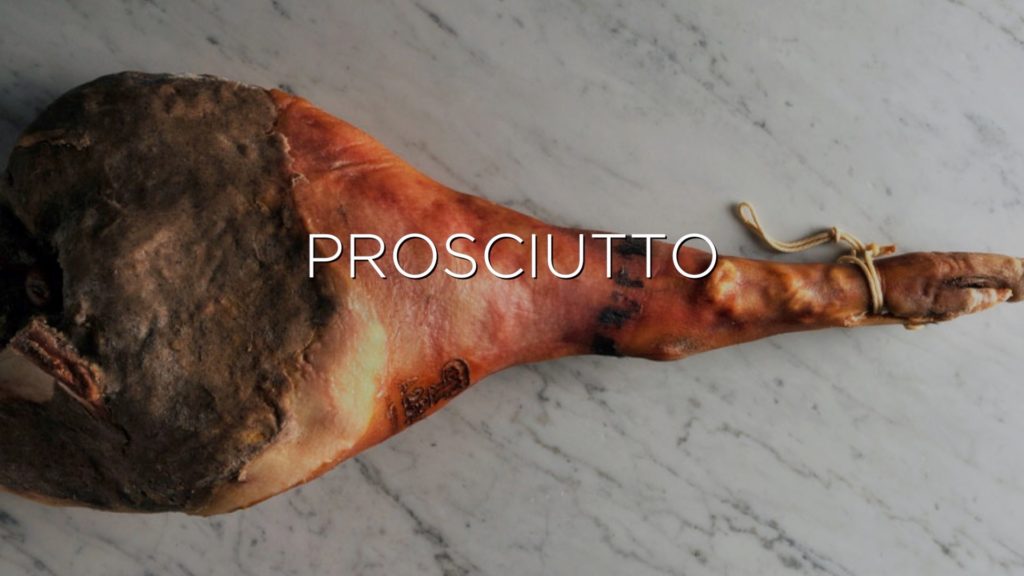
Anita: This stuff, I find it melts in your mouth. Whenever we’ve gotten this from you, it’s just… And we put it on a charcuterie board or anything. It just melts in your mouth. It’s so delicious. Now, when you sell this to people, do you sell the whole leg? Or do you sell it in slices?
Mario: Yeah, we, for the retail market, we sell it in slice packs. We do have some customers that would still take it exactly as it appears like that, the whole bone-in, and then we also sell it in trunks, or de-boned. And then we’ll break it down into smaller pieces, depending on the customer and their need.
Anita: Because you can use it as a charcuterie, but you have to have it very family-sized. But the bigger pieces you can cook with or do things too, right?
Mario: Yep. And you can even hand cut it. I’m trying to get back to the way I was growing up. My dad would hand-cut the prosciutto, and the slices would be a little bit thicker, maybe 16th of an inch, or what have you. But if it’s aged, it breaks apart nicely on the palate. It’s more of a trip because it’s thicker, but it’s still very palatable and very flavorful.
Anita: Yeah. Okay, now this one is something you guys have to talk about.
Dario: Capocollo. This is my favourite, Mario. I don’t know. They are two of my personal favourites. This one is a very underestimated product. It is not easy to do.
Dario: But is one of the most delicious products. And I’ll tell you a story about this, Mario, and then I’m going to let you be with it, explain to everyone. Capocollo in the past to me, it was one of the products that if I would’ve got it anywhere, it used to give me an incredible amount of heartburn. I had a hard time to digest it.
Dario: And again, we go back to the way… I could eat a full piece of Capocollo from Mario, and not have… No feeling, feel really good, and the product is absolutely natural. Which is pretty much the outcome of this.
Capocollo
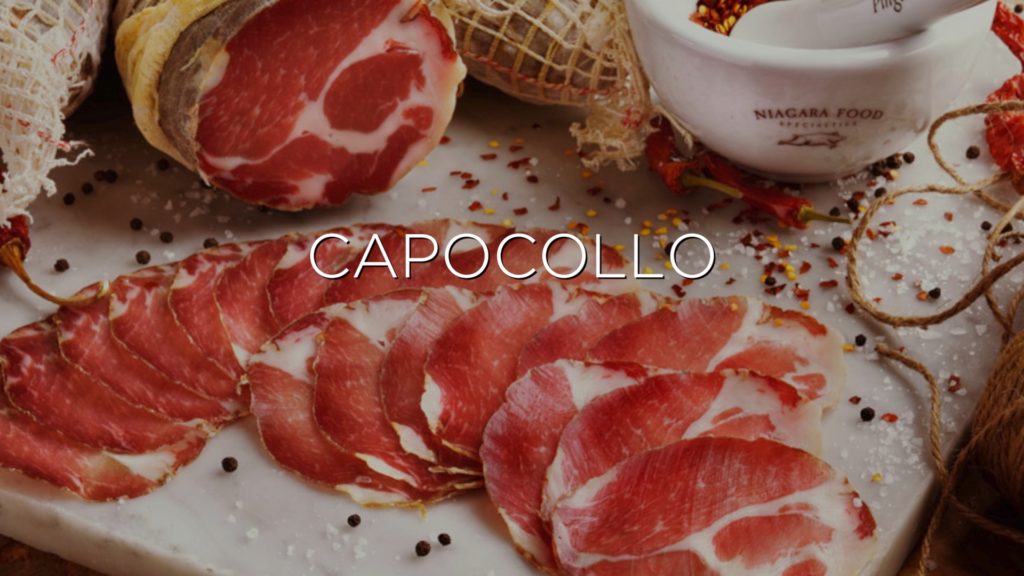
Mario:
Yeah. Yeah, so, our Capocollo or coppa is, it’s a continuation of the… From the shoulder blade up to the collar of the hog. I don’t know if you guys could see that.
Mario: And that’s where the loin becomes really nicely marbled. And the fat content is very important. And Dario, you know about eating it and digesting it. Even my staff, new people that we hire, they go, “I can’t believe how clean it tastes.” How it’s just… You taste the saltiness, you taste the sweetness of the pork, and that’s it. And people often ask us, “Do you do different flavours?” We really have cycled back on the spices and say, “No, we want the pork to be forward.” You see how clean it is, and how tasty. And easy to digest, very easy to digest.
Anita: We have some questions here if you don’t mind me interrupting here.
Mario: Sure.
Anita: Do you ship outside of Ontario? And then they’re making comments about the picture being so wonderful, looks delicious…
Dario: It tastes better.
Mario: Yeah, that’s right.
Anita: Is it lacking other chemicals?
Mario: Is it lacking?
Anita: I guess that’s true, it’s all-natural, right?
Mario: Yeah. So that particular cut is just sea salt and the muscle, the pork. And then if we take it out, we give it a rub with a little bit of lardo, with a touch of pepperoncino. But I mean, just a hint. And maybe a touch of black pepper.
Anita:
Oh, that sounds delicious.
Mario: Kind of adhering to our tradition. My dad, back in the day would put, he would really coat it with a lot of chillies. But we’ve really gone back from that.
Anita: And do you ship outside of Ontario?
Mario: We can from our… We have a new US facility, and we can do it from there. Same product, same process.
Anita: And that’s coming up next month, right?
Mario: Yes, we hope to have it up before Christmas.
Anita: Yeah. So by the time people are watching this, or want to be able to order something, it’s almost like it’s now anyway.
Mario: Yeah. Yes.
Anita: Okay, let’s go to the next one.
Mario: Yeah, it’s another favourite, right Dario?
Dario: Yes. This is… I mean, I want people to look at this picture, and I mean… This is the picture of the product the way you get it. It’s beautiful and fresh, because that looks fresh, right there.
Lonza
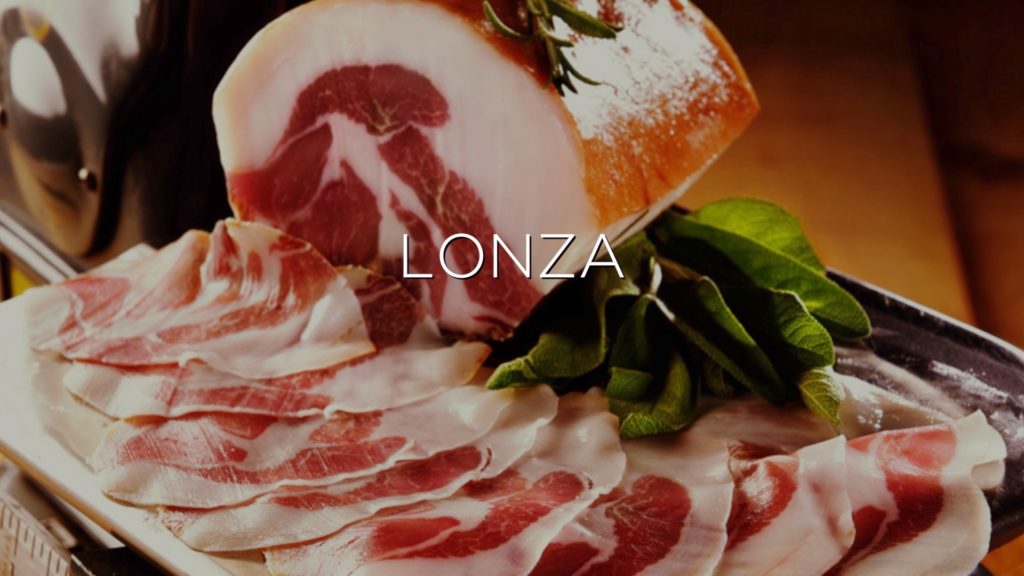
Mario: So, that piece there probably ages for about six to seven months. And in Italy, traditionally they don’t leave that center meat part, they would just do the lardo, the top with a little bit of the meat attached at the bottom. We decided to keep the whole thing because we thought for the Canadian market it would’ve been, being the first on the marketplace to do it in the area, lardo would’ve been a tough sell by itself. But having the little bit of meat gives a little more complexity to the flavour profile, a better chew, and it’s an easier way to initiate people into what lardo’s all about. And, Anita, we should probably talk a little bit about fat. How come you can eat that fat and not get… Sick?
Anita: Who told you that I’m… I’m not crazy about fat? Did Dario tell you that story?
Mario: Yeah. Well, a lot of people shy away, because they say, “Oh, the fat’s not good for you.” I mean, any dietician will tell you, you do need fat in your diet, just stay within the suggested daily limits. Don’t go eating half a pound of and I would come out of the gym sometimes in the morning at 7:00, get into work, have three, four slices of that. I’d forget about lunch, and I was good until 2:00, 3:00 in the afternoon, have an apple, and then get home for dinner. I mean, it’s excellent. It’s a slow burn, the energy is there. A lot of omega 3 and omega 6. The cholesterols that aren’t good for us, during the aging process, are consumed by the enzymes.
Anita: And that’s a huge point because one of the reasons I don’t eat a lot of fat is because at six years old I was diagnosed with high cholesterol, our family was. It’s a family history of that. So I do eat a certain way and cut out fat thinking that, but it’s so true. If you have something that the enzymes actually cut that back, that’s a big thing for people.
Mario: It’s huge. Yeah. Huge. And you’ll notice too when you cook with our products, particularly the pancetta and guanciale, which is more lean for cooking, whereas the other is better served like that, temperature right off the slicer, if you cook with our pancetta or guanciale, if you see the rendered fat in the pan and you let it come to room temperature, it does not solidify.
Mario: It remains as an oil or a liquid. And that’s an indication of LDL and HDL fats that are present. If it was like a bacon fat that was not aged or even a fresh steak, and you cook it in your pan, and the rendered fat, it solidifies at room temperature. It becomes white, and it’s greasy. Ours remains like oil. So it’s easily assimilated by the body. And again, you don’t get eating-
Anita: Everything in moderation, right?
Mario: Yeah. When you’re making a crostini, just have one or two, and not the whole panful.
Anita: Well, that’s what we talk about, everything is about healthy eating and moderation. But I know myself whenever I cook and I put something in the fridge, I wait for whatever solidifies, and I’ll take it off. Because I think that if that’s going to harden when it’s cold, it’s going to harden in my arteries as well, so…
Mario: Exactly.
Anita: I always keep that in mind and that’s a really, really good thing to know.
Dario: We always talk, Mario, and I teach as a chef for it, and I do recommend it because I agree 100% with you. Let’s go back to our ancestors. Your grandfather, your father’s father. How they will stay a full day of work, of really heavy work? Good stuff. Because we talk about good fat and bad fat.
Dario: Especially when you look into charcuterie board, or salumi, like we call it in Italy.
Dario: The first thing they used to come in the morning, I remember, it was, what? A glass of wine, okay, and then, stale bread with some guanciale, or prosciutto, whatever it was.
Dario: We are looking at the quality of the product, and one of the things that you have done, and I’m glad you explain to people because this is so important. When we go to a store and we look into a product, we need to understand where the product comes from. And our reasoning to personally buy the product from Niagara Food Specialties, or in the early 2000s when I was using that product from Niagara Food Specialties, was a specific one. Because I have to think about the well-being of my clients. And of course now the well-being for ourself. And when we create a recipe, when we look into our Mediterranean lifestyle, okay, it’s really looking about the quality of the product that you put in and the quality.
Mario: Yep, yep, yep. And guys, even at lunch here sometimes, I forget to bring something from home, a salad or what have you. Again, it’s two, three slices of salami, that’s it.
Anita: I’d be in trouble working there.
Mario: Yeah, I hear you
Guanciale
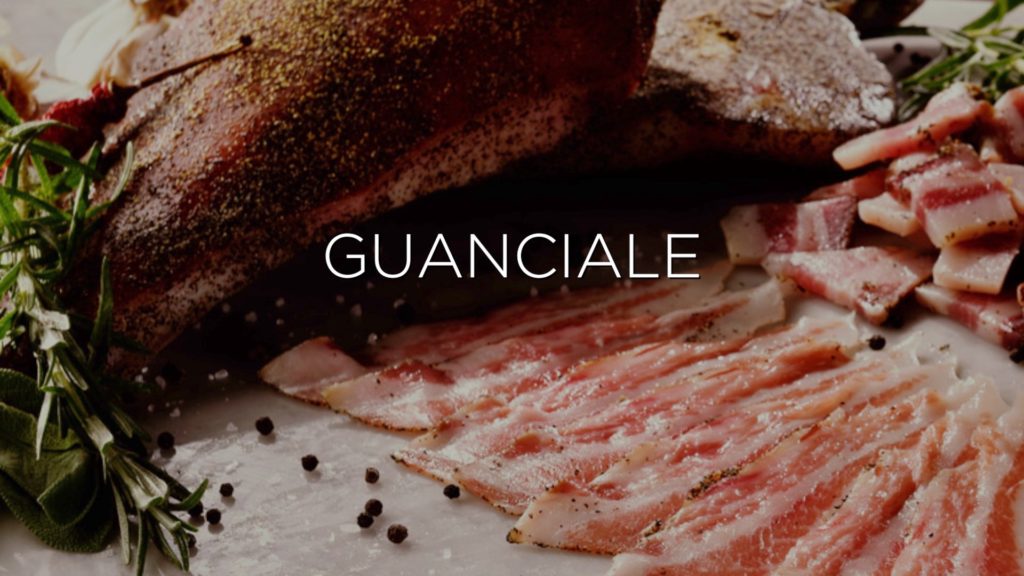
Dario: So let’s talk about the guanciale.
Mario: So the guanciale is from the jowl of the pig or the cheek. And I think it came from necessity, Dario. I mean if we look back 100, 150 years, 400, 500 years, back to the Romans. I mean you grew this animal, you slaughtered it. What do you do with it now? And somebody figured out that salt preserves and every piece that’s worth harvesting is preserved. And the stuff that’s more delicate they would eat tomorrow. So the [foreign language 00:29:36], the liver, the kidneys, la testa, all that would get processed meat within a week or two. And then what could go into salt sustained them for the year.
Mario: So the guanciale, one of my favourites, especially for cooking. It’s got such a rich flavour profile, but yet it becomes delicate quickly. It’s a big impact up front, and then it slowly goes away and lets the other ingredients in the dish take over. For us, I love picking the tomato sauce. And then as people argue, should that be pancetta, I don’t care. I love the argument, I love that discussion. Just make sure it’s good.
Dario: Guanciale any day.
BBQ Sausages
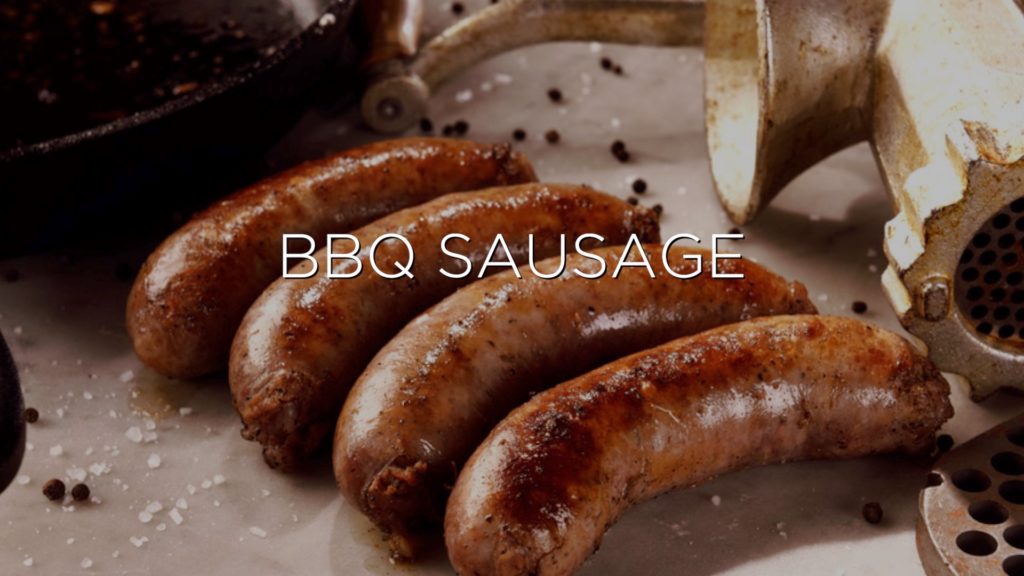
Mario: Yeah. So, yeah. That’s our sausage. One thing I’ve got to say about our sausage, it doesn’t shrink.
Dario: Why? Tell us why?
Mario: Yeah. So I remember when we started making sausage, we did it reluctantly, but we had all this trim meat and we couldn’t make cacciatore at the time, and so we started making fresh sausage. And I remember my wife’s uncle having a barbecue, and, “Hey Mario, bring some of that new sausage you’re making, let’s have a look at it.”
Mario: So I get over there, and he went to a local butcher and he bought 15, 20, whatever he had to buy for hosting the event. And the sausage you put on the barbecue and they looked identical. I said, “Oh my God, that’s beautiful. How are we going to compete? I can’t believe how nice that sausage looks.” Come back eight, ten minutes later, and I realize, “Okay, we have a competitive edge.” Our sausage did not shrink. So I don’t know what the other butcher does, but I’ll tell you what we do.
Mario: We grind the beautiful pork meat we have, and then we add sea salt, black pepper, and then whatever flavour profile. If you want fennel, you want chilli, you want wine with garlic, you want honey garlic, we make it. And that is it. There’s no water pumped into the product. We may have wine, that’s the only liquid ingredient.
Anita: Yeah. That’s so true.
Mario: Right? And yeah, that’s how we make our sausage. So when it goes, when you put down a six-ounce link, you’re going to get some fat that gets rendered out, you’re going to come off with about a five-and-a-half ounce link. And it looks beautiful, same girth, same length, and it’s great-tasting.
Anita: They’re so delicious.
Mario: Yeah.
Anita: And it’s true. A lot of other sausages you get them and then they end up in this little floppy nothing. You get one morsel out of it. So that’s good to know. I have a question here. I guess this would be more for Dario, I guess, but Mario as well. But, guanciale is meant more for carbonara, the dish?
Dario: Carbonara is a classico.
Anita: Because someone’s saying here, “It’s so flavorful. Is it the one that’s the preferred ingredient for that recipe?” So yes it is, right?
Mario: That person is stirring the pot for a big debate.
Dario: Yeah, but I love that, I love the debate, which is great.
Mario: Because someone’s going to say, “Pancetta is for the carbonara.”
Dario: Guanciale to me, is, when we’re looking into the region of Lazio, that’s where carbonara, that’s where amatriciana is. It’s guanciale. It is guanciale. I love it. This is one of the things, it changes complexity. And I have done it many times in classes, when I’ll say, “Make an amatriciana with guanciale, make an amatriciana with pancetta.”
Anita: Yeah. Well, I guess everyone has to try all your products with the carbonara and see. Someone else also has here that the bodies can’t handle processed products, and that’s why your natural ingredients are really, really important. So that’s a good point that somebody had made as well.
Mario: And that’s true. When you have a chemical preservative in your salami, like the sodium nitrites they’re a much bigger molecule than the sea salt molecule.
Mario: And when your body’s digesting, so you make yourself a salami sandwich, or even having bread or crackers on your charcuterie board, and you’ve got your honey and all of the rest of it, as we all know your body prioritizes the digestion and it starts off with the simple sugars, simple carbohydrates, carbohydrates, sugars, then the proteins and the fats. And six hours have gone by and it hasn’t come to the chemicals yet. Your body retains them, because now you’ve gone to your next dinner or breakfast or lunch, and we start the cycle over again. And what does the body do? It’s got to store these things somewhere before it can eliminate them.
Mario: Whereas sea salt, as soon as it touches the palate on your tongue, contact with saliva, that bonds with that saliva, goes right into your bloodstream. The natural chemical ingredients that are in the sea salt, the naturally-occurring minerals, your cells, plasma take what it needs. You have a healthy kidney, your blood is filtered in an hour, and you will urinate out what your body didn’t need. And it’s all-natural ingredients. It’s all good stuff.
Anita: Your body knows. It really does. It’s such a wonderful tool. When you abuse it with all kinds of chemicals and that, it’s really not good. But the next one, is this not the stuff I absolutely love, Dario?
Nduja Spicy Pork Sausage
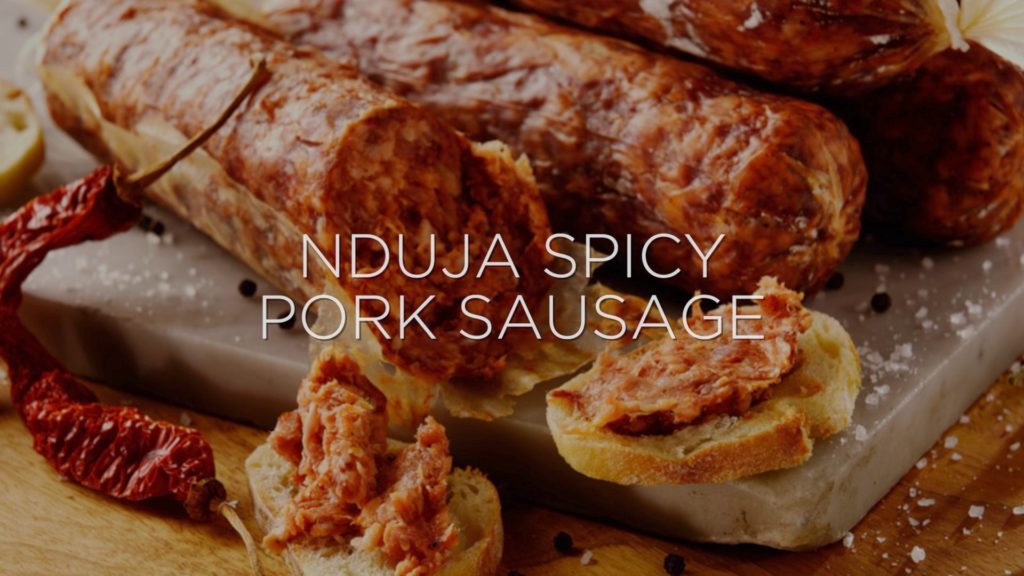
Anita: Nduja is so addicting to me. Delicious.
Dario: Yeah, that’s what we call it.
Anita: It’s spiced perfectly, it’s delicious.
Dario: But you’ve got to, explain a little bit about it.
Mario: Yeah, so I guess in from the Calabrese old-school guys I’ve spoken to, they go back and they talk about these crazy they’ve got, and these old bulls that used to hand-chop the meat. Because they’re probably going to tell you, their grandparents or great-grandparents might’ve been sharecroppers, or might’ve raised a big for the signore, and the signore kept the prosciuttos and the lombo, and he kept the guanciale, and everything else went back to the poor guy. And he didn’t have a grinder. So they used to hand-cut everything, and I think as part of the preservation a lot of chillies went into it, to maybe mask an aged pork flavour before it became preserved.
Mario: And in any case, from that tradition, we’ve got a beautiful charcuterie item, no doubt about it. Nduja’s great on pizza, it’s wonderful on a crostino. Sometimes we’ll put a cheese on it, like sharp cheddar or a Parmigiano shaved. We’ll throw it back into the oven and make a nduja cheese melt. And those are very addictive. And they can ruin an appetite because you can’t stop at one.
Dario: Njuda, it’s one of those items that last because there’s so much work creating it, as you do. But one of the things you always want to make sure is… To really maintain the natural flavour. And I often say, “Don’t screw around with the product. The product is done. Mario and his team spent months and months and months or weeks and weeks and weeks to work on that.”
Dario: This is why my biggest pet peeve, and I was talking to somebody… This morning we were on a phone call with Tuscany and we were talking about products, in general. And I said, “Let’s talk about a pizza with prosciutto.” And the biggest thing that people don’t understand, you make the pizza, you put the prosciutto, then you bake it. That is the craziest thing. The beauty about prosciutto is the natural flavour, okay? So if you want to make a pizza, as soon as the pizza comes out, you put the prosciutto on. So the flavour really can pop. But what Mario was explaining about that good fat, those beautiful elements, all those minerals, hard into the product, come out.
Dario: And that brings also to the way you eat charcuterie, okay? Because when we talk about charcuterie, or when you eat charcuterie or salumi, let’s call it. I personally don’t want to see a knife and a fork.
Dario:
That’s the only way you do it. And I know a lot of people don’t like it, but it’s the best way of doing it.
Anita: Yeah. Well, I think there’s a lot of information today that went out, but I think we’d love to have you back again another time to go more into depth, maybe come up with some recipes and ideas. I know that some people have tried your recipes in the lake here, so in Facebook, they put some great recipes that you guys have to offer, and we’ve got some great ones on our site. So people have a lot of opportunities to try, and I’d love to do some more collaborations with meals and that as well.
Dario: It’s an easy product to utilize, and I’ll speak as a cook. Okay? When you’re using a good product, any ingredients, and I really encourage people to go and research it, and really get that product, because that product makes a difference. Not just in your meal, but in your health. And what we preach all the time, let me tell you one thing. We spend more time figuring out what kind of gasoline to put into our car, but we never think about what kind of fuel we put into our body.
Mario: You’re 100% right.
Dario: And I think Mario’s given us a big lesson. For a product that is so ancient, is so important, that we really don’t understand. And looking for something like that, it’s a meal, right?
Dario: You have something that you want to share.
Anita: So we just, we’ve got three things that we’re going to end with here, and we’d love to have you come back. Number one is, we’ve got our board ready backyard, what is it, backyard boards or something? Oh my gosh, we love this board, so we’re going to need some of your charcuterie. So I guess we go to your link that’s available at Niagara Specialties?
Special for our International Dinner Club Members
Anita: We’ll put the link in here as well in the Facebook group and then we’ll add it to wherever else we do so people can go there. We’re offering a special for our people in our membership, in our International Dinner Club. Do you want to explain it, Mario, just so we make sure we’ve got it correctly?
Mario:
So we are, so you’re going to provide them with a code.
Mario: When they place their order, and we will be adding a bottle of Grandpa olive oil.
Mario: Which is, it’s excellent quality and it’s been winning awards like crazy, and we’d like to share that with your customers and friends.
Anita: Oh, that’s so great.
Mario: No, it’s this crazy story. One of my customers is of Turkish origin, and he buys a lot of our products. And he went home and he came back and goes, “Guys, you’ve got to try this olive oil.” And I’m rolling my eyes, like “Okay, come on.” And guess what? It is a fantastic oil. And we took it on as a pet project, and it’s an excellent, excellent quality oil.
Dario: And it’s winning awards already?
Mario: It took 20, it must’ve had, I don’t know how many golds in all of its competitions that it’s entered, just in 2020. And already for the 2021 harvest, they just won a medal last week. They entered it early, and it’s already took a gold, I can’t remember which competition, but I was just talking to my brother this morning and he told me.
Anita: That’s wonderful.
Dario: What a gift.
Anita: Wow. Wow. Thank you so much.
Dario: Thank you, Mario. Yes.
Anita: That’s really, really kind of you. So we’ll put the link and all that details for the people in our membership so they’ll be able to have that.
Anita: And we do have one other question with that we’re going to leave with. And I can’t pronounce it, so Dario has to do it.
Dario: Sopressata.
Anita: You still make sopressata?
Mario: Yes.
Dario:
What is it?
Mario: This is it.
Anita: That looks way too good.
Mario: Yeah. So that there folks was made on June, oh let me think, June 24, okay, and we’re just packaging it today.
Anita: Wow.
Mario: So how many months is that?
Dario: Yeah. So that’s three months, four months.
Mario: June. So you’ve got July, August, September, and most of October. So almost four months, 18 weeks. Commercially, most guys make that soppressata in probably, three to four weeks tops. So…
Dario: It’s a labour of love, I swear to God. I mean, we don’t realize it. And we are a bit biased on the product because we do believe we know how much work is behind it. And it’s not so much the work, I mean obviously, there is a passion, which we always believe, that first thing in the morning, soon as you put your feet on the ground, passion is to be high. If passion is not high, go back to bed and think about the next day.
Mario: That’s it.
Dario: And number two is, the investment on your life. Investment, I mean, I don’t know if people know, Mario has a client in Canada but in the past, what, how many years now?
Mario: Three.
Dario:
They just opened a new place in the US.
Mario: Yeah, three years in the making.
Anita: And a lot of passion goes into what you’re doing and your business right?
Mario: Yes. It’s crazy.
Mario: Yep. And when people ask, “Which is your favourite?” They’re all favourites. Like you said, going back to Dario’s passion. If you don’t enjoy it, don’t do it.
Dario: If you don’t have passion….Go back to bed.
Dario: I mean, it’s the impact you have. I mean for us, Mario, and I speak on behalf for myself and Anita, is when we talk about Mediterranean living, it’s mindset strategy but it’s also how you think. And I go back to the thing about what we put into our system, and how we… And connecting. We give you that olive branch, go live your life. We share the olive branch. But the olive branch I was sharing was just a piece of bread and some good salami.
Mario: That’s right.
Dario: Because that’s what I remember when we get home. When we go home to our friends, we sit down at the table, and guess what is there? Some salumi.
Anita: I’m getting very hungry. Very, very hungry. Well thank you so much Mario for joining us today. And again, we have to have a number two and products and recipes and go from there, so.
Mario: Yeah. And thank you guys for sharing.
Dario: Well, you only share quality. Right?
Mario: Thumbs up.
Anita: Thanks so much for joining us, and we’ll be sharing the links and everything on all our socials that we’ll be putting up. And it’s always an advantage to come LIVE because you can ask questions directly to Mario, so… Thanks to everyone that joined us on the Facebook group.
Mario: We’re going to have you guys in our kitchen and we’re going to do a carbonara, and we’re going to do an amatriciana.
Dario: As long as we do it with guanciale.
Anita: Can I be the taste tester?
Mario: Absolutely.
Anita: I’ll be the main judge.
Mario: Absolutely.
Dario: You always got to keep the andouille away from her. Because she will… Nduja in this house doesn’t last.
Mario: Okay, I hear you.
Anita: We got that from you one time and it was just heavenly.
Mario: All right.
Dario: Thank you, Mario, thanks for your time.
Anita: Ciao, thanks so much. Bye-bye.
Mario: Ciao.
Interview by Chef Dario Tomaselli & Anita Heidema with O’Live Your Life.
For more information come over and subscribe. www.oliveyourlife.org

